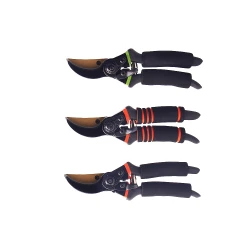Here are some features and considerations when choosing a garden pruner
2024-03-22
A garden pruner, also known as pruning shears or secateurs, is a handheld gardening tool used for cutting and trimming plants, shrubs, and small branches. Pruners come in various types, sizes, and designs to suit different gardening tasks and preferences. Here are some features and considerations when choosing a garden pruner:
Features of Garden Pruners:
1. Blade Material: Pruners typically have blades made of hardened steel or stainless steel for durability, sharpness, and resistance to corrosion.
2. Blade Type: Pruner blades may be bypass, anvil, or ratchet style.
Bypass Pruners: Feature two sharpened blades that slide past each other like scissors, providing clean cuts on live branches.
Anvil Pruners: Have a single blade that cuts against a flat surface, suitable for cutting dead wood and tough stems.
Ratchet Pruners: Utilize a ratcheting mechanism to make cutting easier, especially for thicker branches.
3. Cutting Capacity: Consider the maximum cutting diameter or thickness of branches that the pruner can handle, ensuring it meets your gardening needs.
4. Handle Design: Pruner handles may be straight, curved, or ergonomically designed for comfortable grip and reduced hand fatigue during extended use.
5. Safety Lock: Many pruners feature a safety lock mechanism to secure the blades when not in use, preventing accidental cuts and injuries.
6. Spring Mechanism: Pruners may have a spring mechanism that automatically opens the blades after each cut, reducing hand strain and allowing for faster cutting.
7. Replacement Parts: Look for pruners with replaceable blades, springs, and other parts for easy maintenance and extended tool lifespan.
8. Grip Material: Pruner handles may be covered with rubber, plastic, or foam grips to provide better grip and control, even in wet conditions.
9. Weight: Consider the weight of the pruner, as lighter models may be more comfortable for prolonged use, especially for gardeners with arthritis or hand fatigue.
10. Pruning Type: Choose a pruner suitable for the type of pruning you'll be doing, whether it's precision trimming of delicate flowers, shaping shrubs, or pruning thick branches.
11. Brand Reputation: Research reputable brands known for manufacturing high-quality pruners with reliable performance and customer satisfaction.
Considerations When Choosing a Garden Pruner:
1. Gardening Tasks: Determine the specific pruning tasks you'll be performing, such as deadheading flowers, shaping shrubs, or cutting branches, to choose the appropriate type and size of pruner.
2. Hand Size: Consider the size and comfort of the pruner handles relative to your hand size, ensuring a comfortable grip and ease of use.
3. Blade Maintenance: Check if the pruner blades require sharpening or maintenance and ensure the availability of sharpening tools or services.
4. Budget: Set a budget for the garden pruner and compare prices, features, and quality among different brands and models to find the best value for your needs.
5. User Reviews: Read reviews and feedback from other gardeners to learn about their experiences with different pruners and choose one that meets your expectations.
6. Warranty: Look for pruners with a warranty or guarantee from the manufacturer to provide peace of mind and protection against defects or premature failure.
Overall, a garden pruner is an essential tool for maintaining healthy and beautiful plants in your garden, providing precise and efficient cutting for a wide range of pruning tasks. By considering the features and considerations outlined above, you can choose the right garden pruner to suit your gardening needs and preferences.



